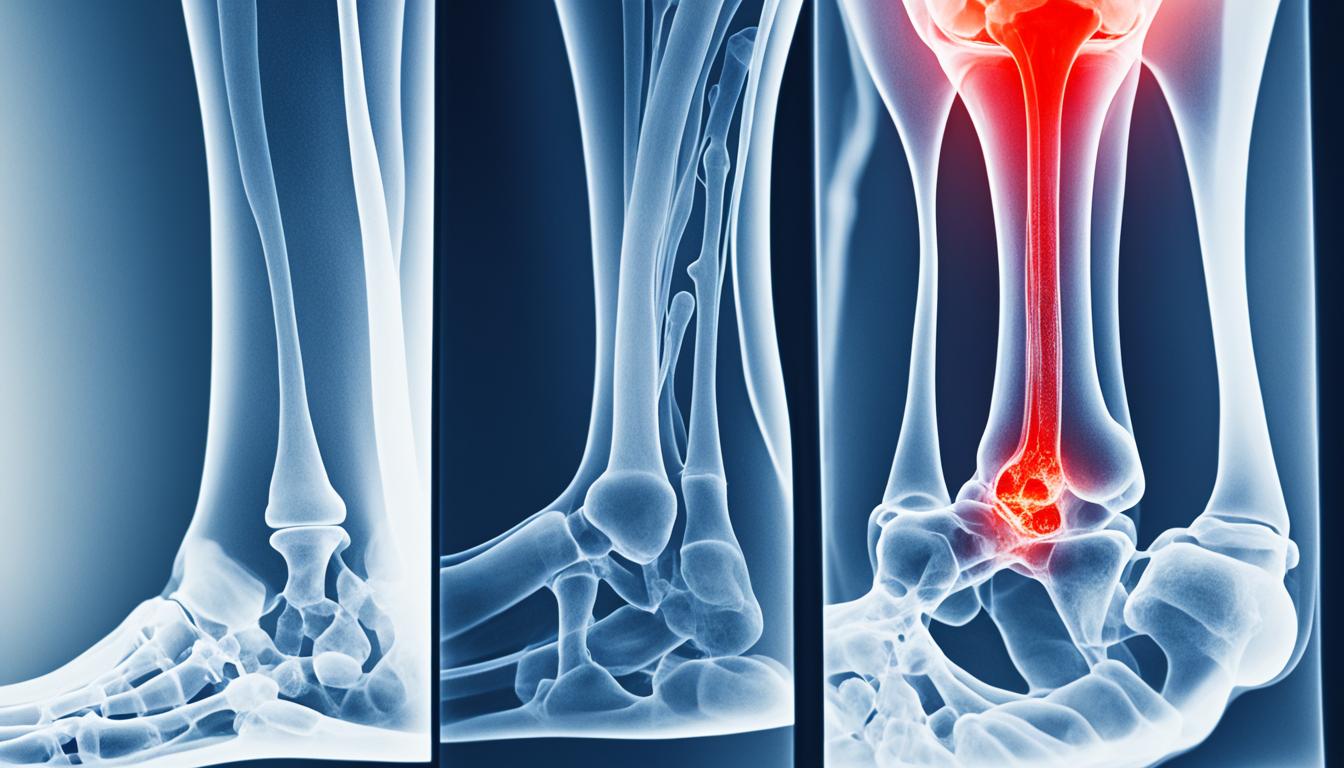Paget’s disease of bone affects one or multiple bones and is quite common. Some people don’t feel any symptoms, while others may experience bone pain and shape changes. This condition causes more bone to be taken away than is replaced, leading to a mix-up in how bone is formed and extra blood vessels in the bones.
Doctors often use bisphosphonates to treat Paget’s disease. This group of drugs helps control the symptoms. Stem cell therapy has also shown some promise in treating Paget’s disease by potentially helping with its management.
Key Takeaways:
- Paget’s disease of bone is a skeletal disorder that can affect one or multiple bones.
- Symptoms of Paget’s disease can include bone pain and deformities.
- Increased osteoclastic bone resorption and disorganized bone formation are characteristic of the disease.
- Bisphosphonates are commonly used to treat Paget’s disease and manage symptoms.
- Stem cell therapy shows promise as a potential treatment option for Paget’s disease.
Epidemiology and Pathophysiology of Paget’s Disease of Bone
Paget’s disease of bone is a common issue where bones become weak and break easily. It is often seen in white adults over 55 years old. The chance of getting this disease goes up as people age. Men seem to get it a bit more than women do.
In places like the United Kingdom and Western Europe, more people get Paget’s disease. This could be because of certain genes and the environment. It’s known that too many of the cells that break down bone gather in pagetic bone. This causes the bones to look and behave differently than they should.
Infections like certain viruses, and contact with things like arsenic, might cause Paget’s disease too. These things, along with how our genes work, can lead to the disease. Learning about how Paget’s disease spreads and affects the body is very important for finding it early and treating it right.
Prevalence of Paget’s Disease
Here’s some data to see how common Paget’s disease is:
| Age Group | Prevalence in white adults (%) |
|---|---|
| 55-64 | 1.0 |
| 65-74 | 1.5 |
| 75-84 | 2.5 |
| 85+ | 4.5 |
This table shows that Paget’s disease is not very common. But, it does happen more as people get older. It affects how strong and healthy the bones are. Our genes and what we’re exposed to can make it more likely to get this disease.
Pathophysiology of Paget’s Disease
Paget’s disease changes how bones rebuild themselves, causing them to get weaker over time. In the sick part of the bone, the cells that break down bone work too hard. This makes the bone break down more than it should, making it weaker and stranger looking.
Problems with how our genes and environment affect bone-making activities can lead to Paget’s disease. A gene called SQSTM1 might make you more likely to get this disease. Being around certain viruses or toxins like arsenic can start this disease in those with the gene.
Experts are learning more about Paget’s disease to help with spotting it early and treating it well. Finding it soon and treating it like you should is key to having fewer problems and a better life with this condition.
Symptoms, Diagnosis, and Treatment of Paget’s Disease of Bone
Paget’s disease of bone can sometimes cause bone pain, deformities, fractures, and arthritis. It can affect bones like the spine, pelvis, femur, tibia, and skull. Symptoms vary in how severe they are and which bones they impact.
To diagnose Paget’s disease, doctors often use radiography. This imaging technique shows changes in affected bones, which appear thickened or misshapen. Blood and urine tests may also be used to measure certain markers that show disease activity.
Treating Paget’s disease might involve bisphosphonates like alendronate and pamidronate. These drugs aim to stop excessive bone breakdown. They can lessen bone pain and reduce further deformities. Calcitonin is another option to slow down bone turnover and relieve symptoms.
Conclusion
Paget’s disease of bone is a chronic disorder affecting bone health. It can cause your bones to be not shaped right. Some people with this condition don’t feel any different, but others might face bone pain and breaks.
The usual way to treat this disease is with special medicines. These drugs help stop the break down of bones. This can reduce pain and other symptoms.
Recently, stem cell therapy has caught the eye of doctors. Stem cells can turn into different cell types, like the ones that make bones. This might help fix bone problems in new ways. Even though more study is needed, this type of therapy could be a big help in the future.
If you have Paget’s disease, getting the right diagnosis and treatment is key. This can help you control symptoms and feel better. It’s important to have regular check-ups with your doctors to monitor how you’re doing.
By keeping up with your treatment and staying in touch with your doctors, you can make each day better. Working together with healthcare providers is essential. This way, you can make healthy choices and enjoy life more fully.

